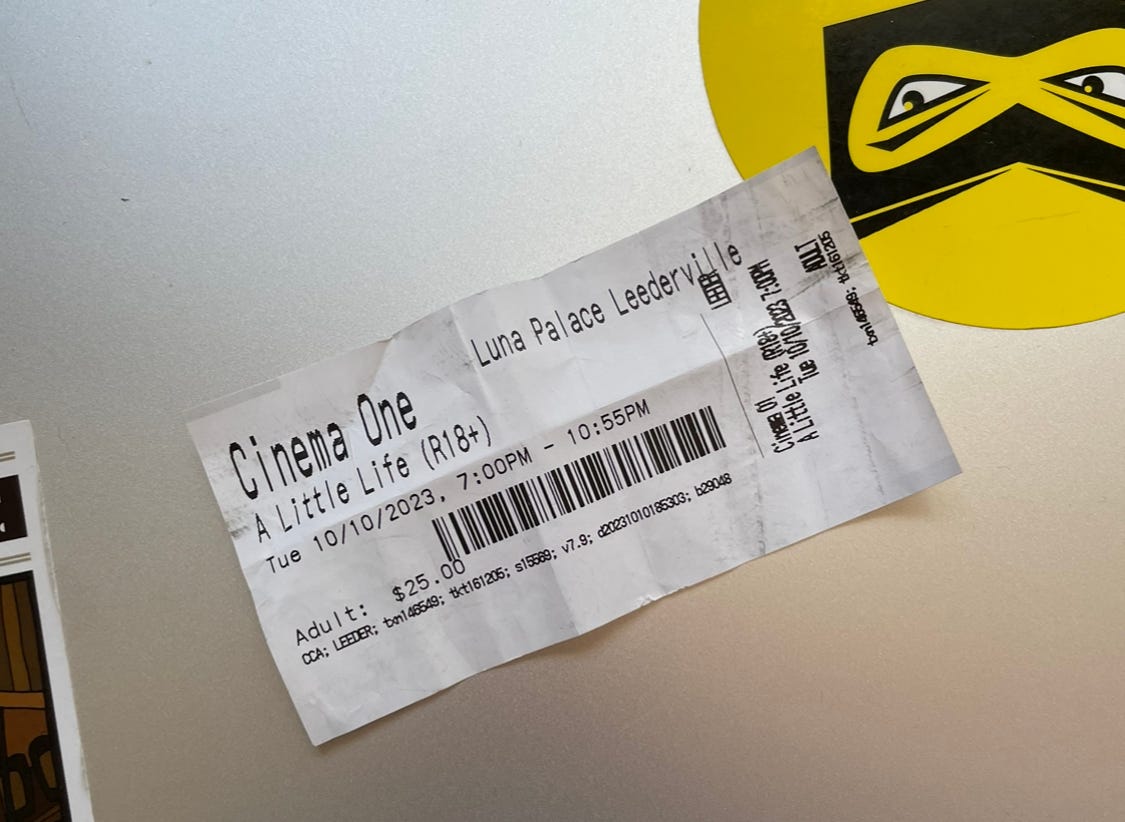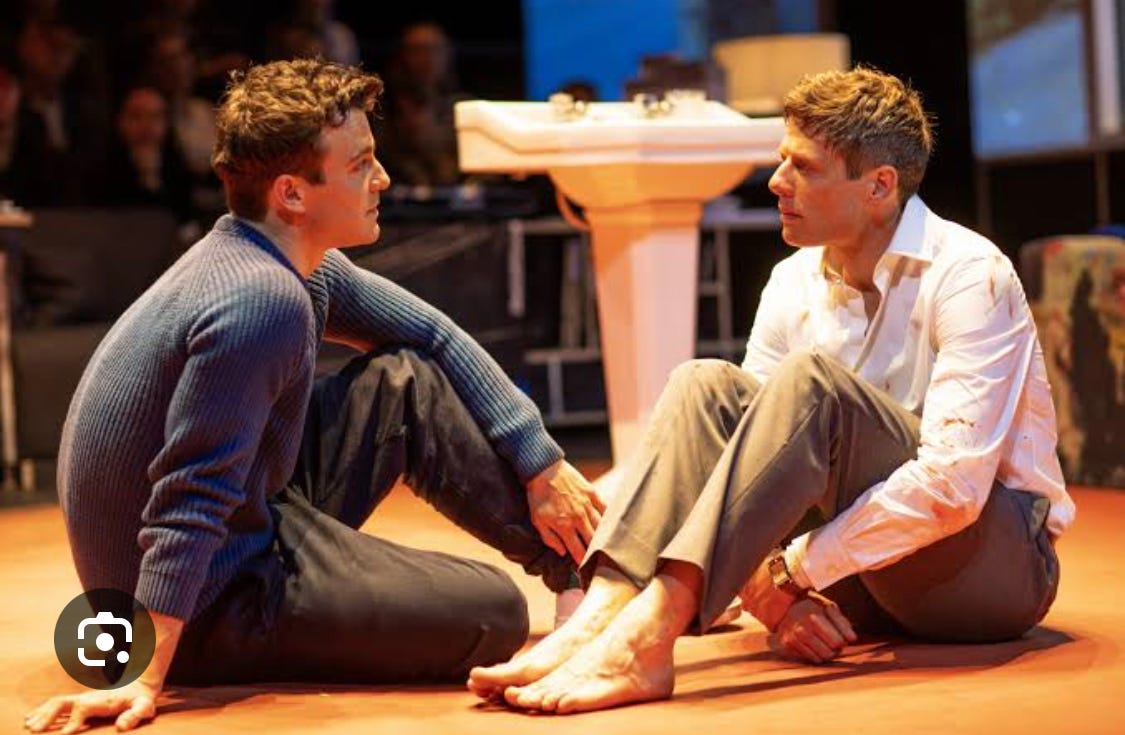There is a little independent theater just outside of the city. It is small and old and a little grimy. It’s age means that it lacks the polish of newer cinemas. The red velvet chairs are tattered and fraying, the red carpet is dark and worn in places. The candy bar is tiny and the staff are all decidedly ‘alternative’. Most of the screening rooms are just that, rooms. They are small and hold about 24 seats. Going there is an entirely different cinema experience and I love it. They show independent movies and foreign film festivals. They offer an alternative movie going experience for those who do not love Hollywood blockbusters. The place has personality, and charm. Something I find is in short supply in modern design. I think once upon a time, in a previous life, Luna cinema may have been a theatre, as the big room is exactly that. It is a big theatre with a stage and a dress circle (that is now unfortunately inaccessible). I couldn't think of a better venue to see A Little Life.
A Little Life by Hanya Yanigahara is an epic tale of trauma and grief and love and friendship. It is an acclaimed book. It is my favourite book. And it is a very hard book to recommend. A Little Life is tender and brutal. Yanigahara does not flinch away from the most horrific aspects of life. Instead she invites you to bear witness to it. In contrast, the play forces you to bear witness.
The play was first adapted by Ivo Van Hove in Dutch by the International Theatre Amsterdam, before being adapted in English for the West End. Now, I am not an avid theatregoer, and I know basically nothing about plays. But I do remember hearing about this adaptation when it was first announced. It was said to be innovative and confrontational. Van Hove condensed the 700-ish page slow burn into four hours of emotional carnage. It received critical reviews, and the closest it ever came to me was the 2023 Adelaide Festival – which isn’t all that close. And then the English production enjoyed a long (but not long enough) run in London. I was there in August and missed the opportunity to see it by a month. So, you can imagine my joy when a limited cinema release was announced. I saw this on Hanya Yangihara’s Instagram account as she has closely documented the English production, which she helped adapt. So, I bought my ticket and prepared as best I could for the experience.
And the play was exactly that, an experience. From the moment the curtain rose I found myself completely engrossed. The emotion was visceral. It was 4 hours of carnage and I couldn’t look away, even when I wanted to. The set design was simple but effective. The sound design was spectacular, the string quartet providing the perfect accompaniment. I often forgot I was watching a play, the actors breathing so much life and authenticity into the characters. This was easily the best adaptation of anything I have ever seen. The constraints of the form meant that the approach to bringing the book to life had to be innovative – and it was. The narrative collapsed time, meaning that Jude’s life happened to him almost simultaneously. And the ‘villains’ all being played by the one actor was brilliant, both symbolically and as far as the acting (big props to that guy). I don’t know how I expected the depictions of self-harm to be portrayed, but I was surprised by how realistic it was. The fake blood felt real. For me the true masterstroke was having Jude remain in his blood stained clothes for the majority of the play. Symbolically it perfectly represented how ever-present Jude’s injuries were. No matter when the injury had occurred, whether it was the abuse he experienced as a child or the self-harm he inflicted throughout his adult life, it was always there. For he lived his life covered in the blood and scars of those things. He never got to reclaim his body, or exist free of the torture he had endured. His trauma was real, and always there. It was uncomfortable to watch. I found myself wishing that he would change. That he would emerge clean and free. But he doesn’t, and that's the point. A Little Life does a lot, but one thing it does best is demonstrate how the unseen and unspoken traumas of life can consume you. In real life they may be easily hidden, but not here, not for Jude. The victims have to live with it, in bloody clothes and bruised bodies.
The trigger warnings for this play are extensive. There is a big difference in reading something’s and having to see them. The violence depicted on the stage was almost too much. Hell, it might have even been too much at times. I was overwhelmed, and uncomfortable, and sick to my stomach. But you’re supposed to be. This is a challenging play, based on challenging source material.
The adaptation wasn’t perfect. There were many changes from page to stage. The relationship between the four boys is not as well fleshed out, and Malcolm and JB become auxiliary players. The stage, being smaller than the page, means that Jude’s world seems smaller too. I feel that reading the book definitely changed my experience, as I was able to bring all the things that weren’t on the stage with me. What impressed me most was that the play made me feel the things I felt when reading the book. It felt that whatever changes were made, the heart of the thing was the same. It was still Jude’s story.
And Jude’s story is, well, it’s awful. Its’ sad, and traumatic, and bleak, and seemingly devoid of hope. But I think it is still important. It is important that there are narratives that explore trauma and the traumatized that aren’t redemptive, because sometimes the world has no redemption to offer. Sometimes there is no healing, just holding the pieces desperately together. Sometimes broken things aren’t made beautiful. There is no transformation. No pithy takeaway, no inspiration. Sometimes, someone’s pain is just pain. And they deserve no less compassion or empathy. Maybe there are some things you can’t come back from. Maybe there are clouds without silver linings. I’m lucky that this isn't true for me. But this book and this play have taught me that it’s important to understand that it is true for some people. Ultimately, I think, it is a testament to love. No matter what, you should be kind and loving – to everyone, to everything.
And so I try to be kind to everything I see, and in everything I see, I see him.







This is so interesting! I don’t think I could handle watching the play, but I loved the book. Admittedly it’s been years since I read it, but I remember feeling that it was a redemptive tale--even with the tragic ending. Friendship is the redeemer, the hope. Finding people in this big wide world and loving them. Maybe it’s time for me to revisit this one and see if I have a different perspective!
This was a lovely piece, Evelyn (chicken).
Your love for the book, the play, and the underlying message that both carry really shines through in this piece, and it makes the whole thing so enjoyable to read.
Even though there were many more lines that I really enjoyed below are two that stuck out:
“The red velvet chairs are tattered and fraying, the red carpet is dark and worn in places. The candy bar is tiny and the staff are all decidedly ‘alternative’.” — lovely description.
“The place has personality, and charm. Something I find is in short supply in modern design.” —- I love it! I couldn’t agree more.